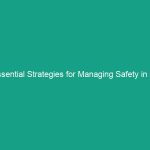Good Morning Team!
Today, we’re going to discuss a vital aspect of Workplace Safety: Essential Stopping Work Guidelines. Understanding and implementing these guidelines is crucial to ensure our Safety and well-being. By adhering to these protocols, we can avoid critical Safety risks that could jeopardize our health and productivity. Let’s dive in!
Understanding Essential Stopping Work Guidelines
The phrase Essential Stopping Work Guidelines refers to the protocols and Procedures that employees must follow when they encounter unsafe conditions or Hazards that may compromise their safety or the safety of others. These guidelines are designed to empower you to take immediate action and prioritize safety in the workplace.
Why are these guidelines important? They help create a culture of safety where every employee feels responsible for their own safety and the safety of their colleagues. Moreover, they serve to minimize accidents and injuries, thus maintaining productivity and morale.
One common misconception is that stopping work might lead to delays or loss of productivity. However, the truth is that a safe work Environment is crucial for maintaining long-term efficiency and effectiveness. Remember, safety should never be compromised for the sake of speed.
Key Hazards, Risks, and Safety Considerations
Let’s identify some specific hazards and risks that can arise in our work environment:
- Unsafe Equipment: Faulty tools or machinery can lead to serious injuries.
- Environmental Hazards: Poor lighting, slippery floors, or exposure to chemicals can create immediate risks.
- Poor Communication: Lack of clear signaling or warnings can lead to accidents.
Ignoring safety protocols can have severe real-world consequences. For example, a minor oversight in Equipment Inspection could result in malfunctioning machinery, leading to injuries or even fatalities. It’s imperative that we remain vigilant and proactive in addressing these risks.
Best Practices, Procedures, & Actionable Advice
Here are some essential steps to follow when you encounter a potential hazard:
- Assess the Situation: Evaluate the environment to identify immediate risks.
- Stop Work Immediately: If you believe there is a danger, stop all operations immediately.
- Notify Supervisors: Report the hazard to your supervisor or safety officer without delay.
- Document the Hazard: Take notes or photographs if possible; this will assist in investigations and corrective actions.
- Follow Up: Ensure that appropriate measures are taken to address the issue before resuming work.
For instance, consider a situation where a worker notices a leak in a chemical storage area. By following the stopping work guidelines, they can prevent potential exposure to hazardous materials, protecting not only themselves but also their coworkers.
Regulations, Standards, and Compliance
It’s important to understand that our stopping work guidelines are not just Best Practices; they are often backed by Regulations and Standards. The Occupational Safety and Health Administration (OSHA) and other regulatory bodies have established guidelines that require employers and employees to maintain a safe working environment.
Why is compliance critical? Adhering to these regulations not only protects employees but also shields the organization from legal repercussions, financial losses, and reputational damage. Always familiarize yourself with the specific safety standards applicable to your role and workplace.
Employee Engagement & Discussion
Now that we’ve covered the essential stopping work guidelines, let’s open the floor for discussion. Here are some questions to consider:
- What safety challenges have you encountered related to stopping work?
- How comfortable do you feel reporting a hazard to your supervisor?
- What additional resources or Training would help you feel more prepared to handle unsafe situations?
Your input is invaluable in fostering a culture of safety, and sharing experiences can help us all learn and improve.
Conclusion & Key Takeaways
In conclusion, the Essential Stopping Work Guidelines are critical for maintaining a safe working environment. Remember the key points we discussed:
- Understand the importance of stopping work when hazards arise.
- Know the steps to take when you encounter a potential danger.
- Familiarize yourself with applicable regulations and compliance standards.
- Engage in discussions about safety and share your experiences.
As we wrap up, I want to emphasize that your safety is our top priority. By applying these practices diligently, you contribute to a safer workplace for everyone. Thank you for your attention and commitment to safety today. Let’s make it a great and safe day!


